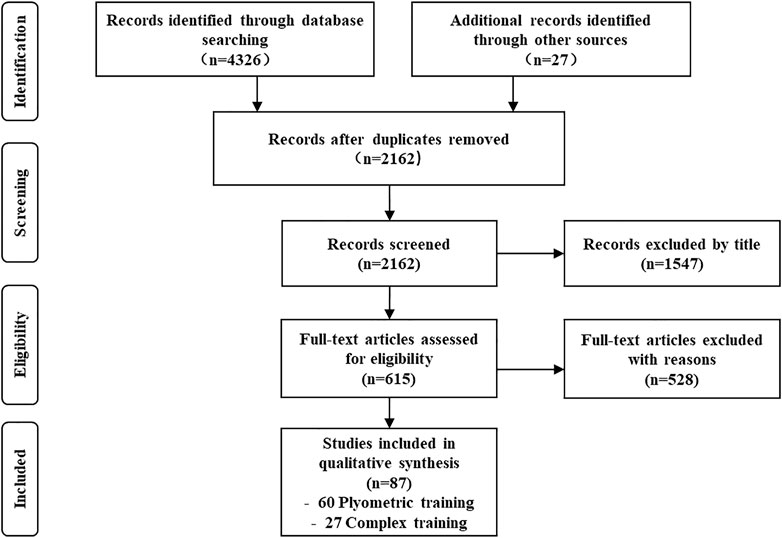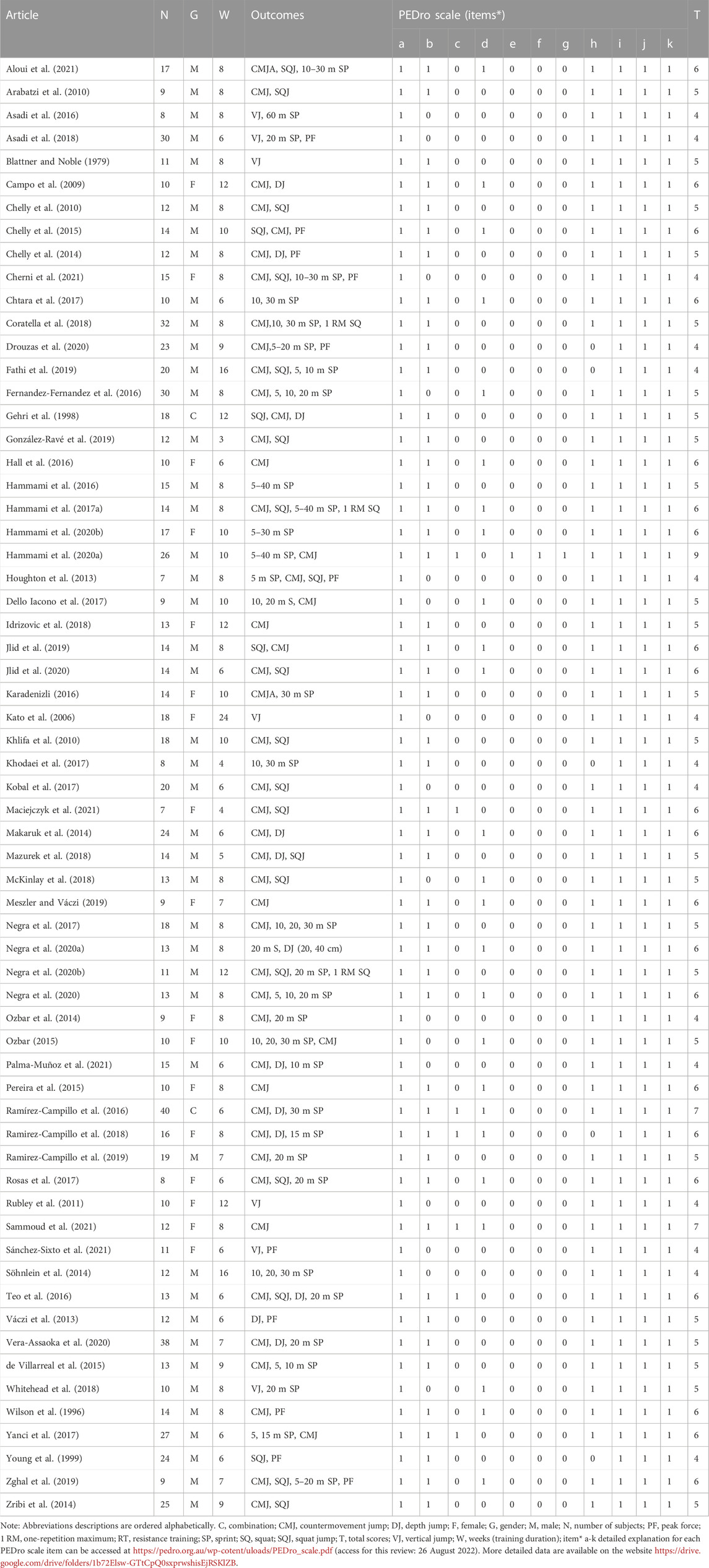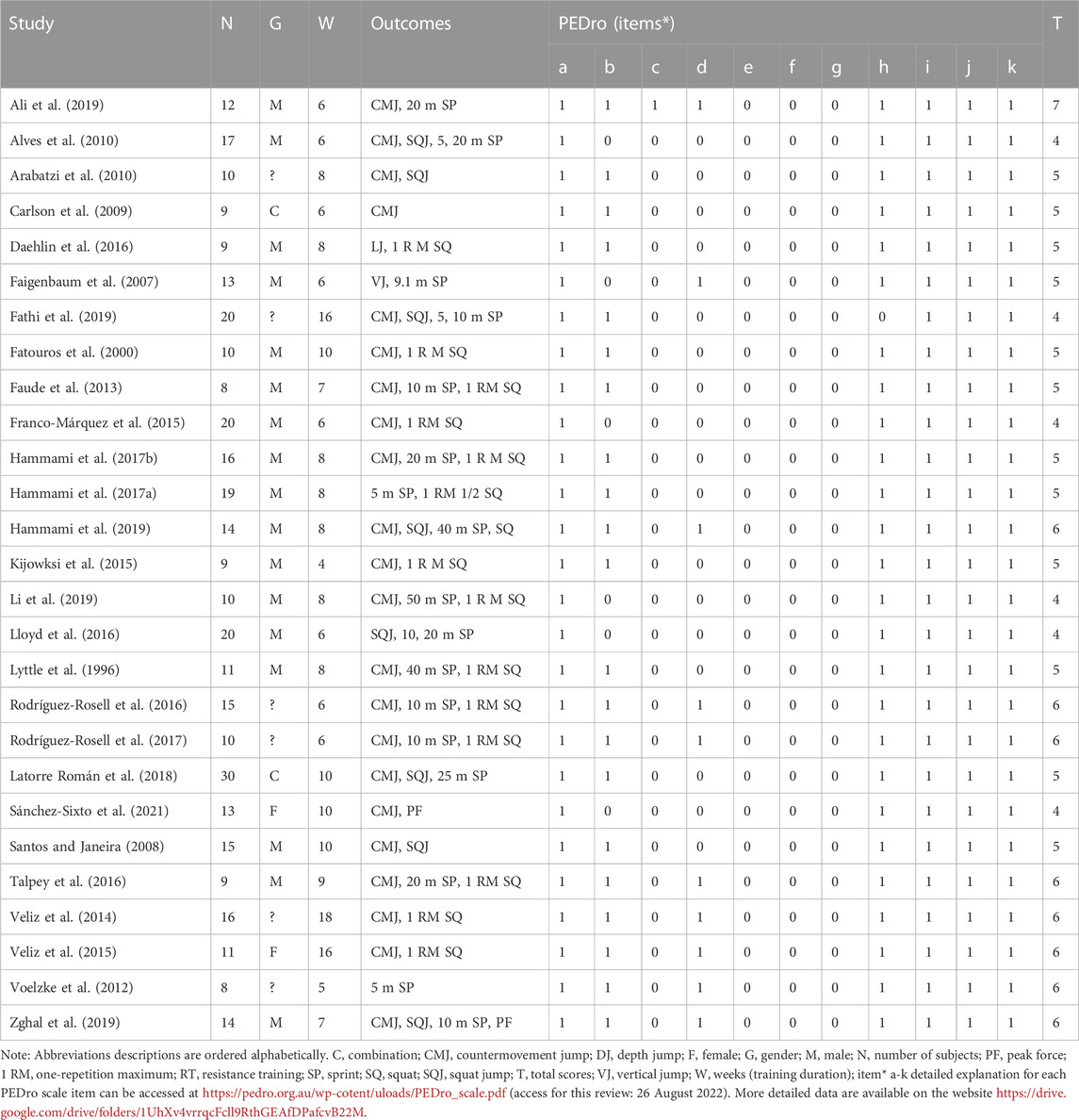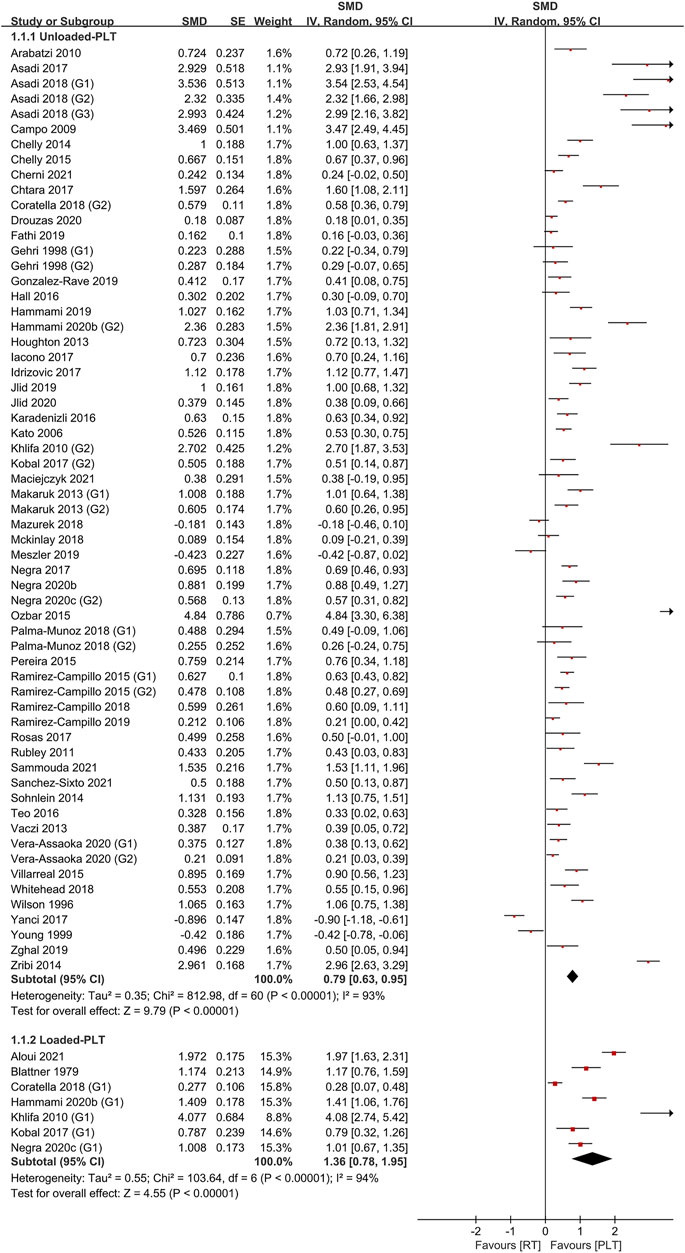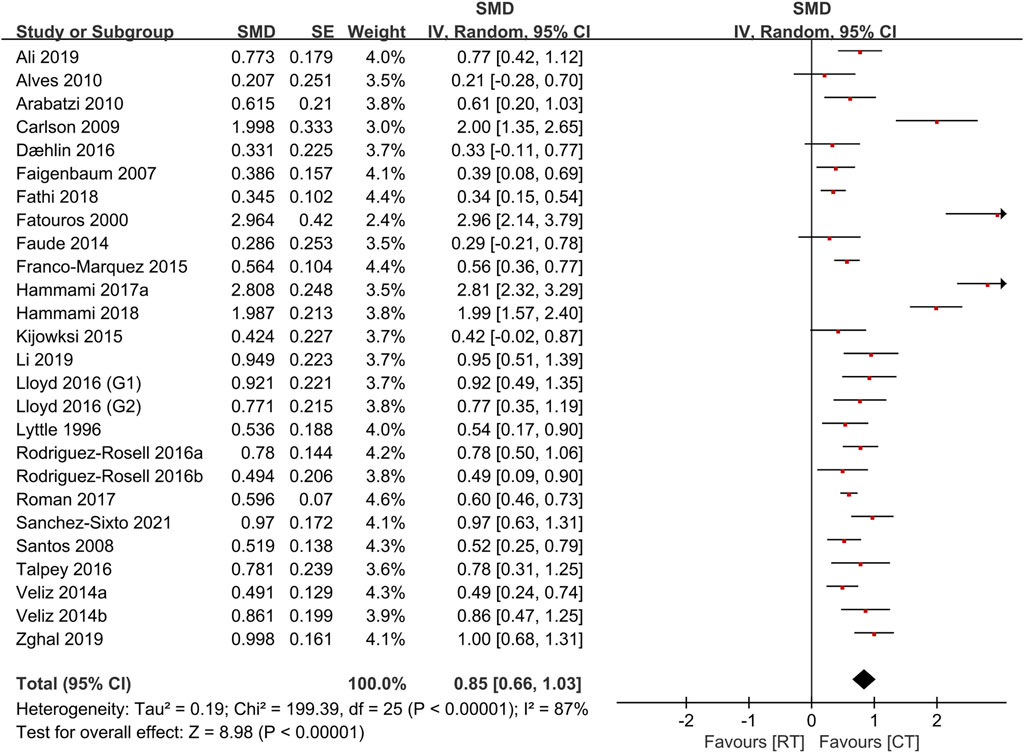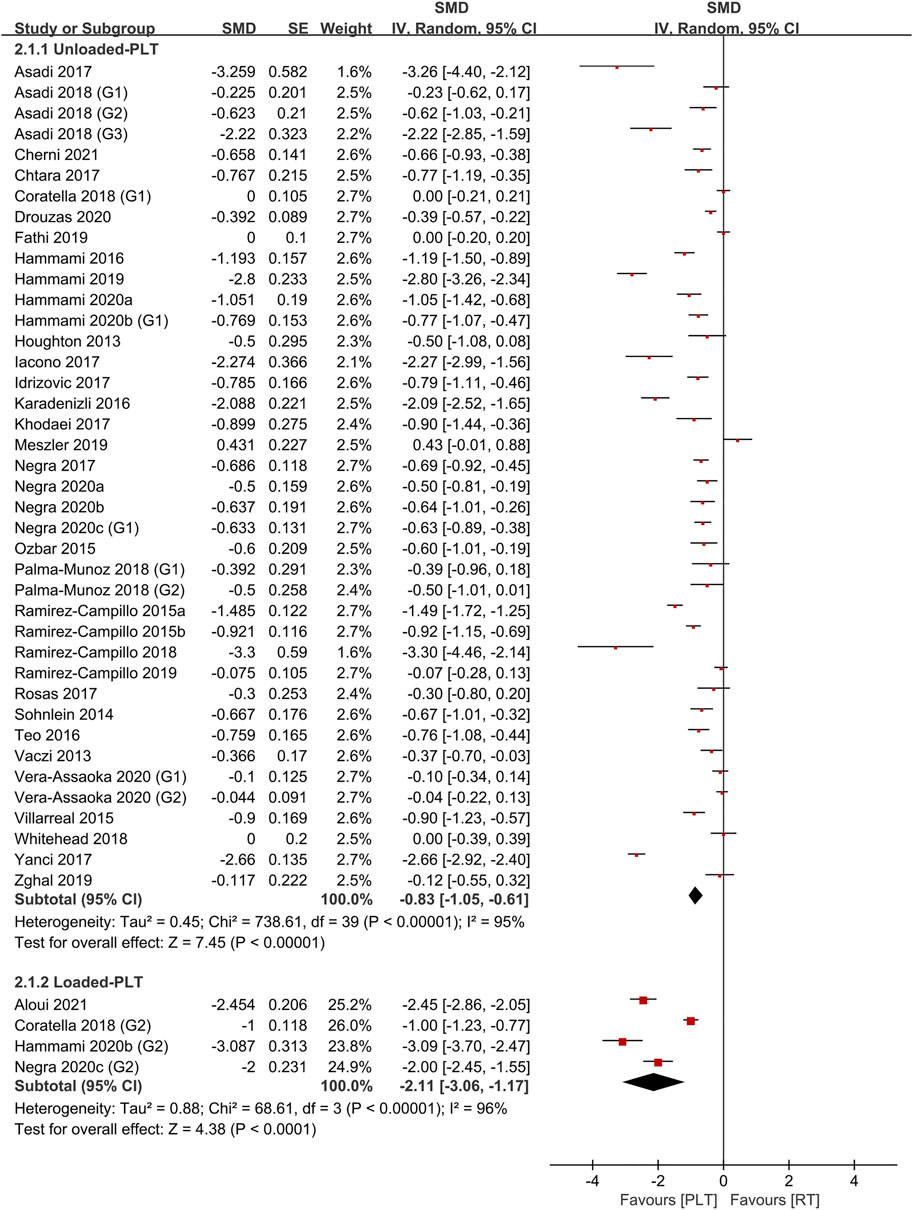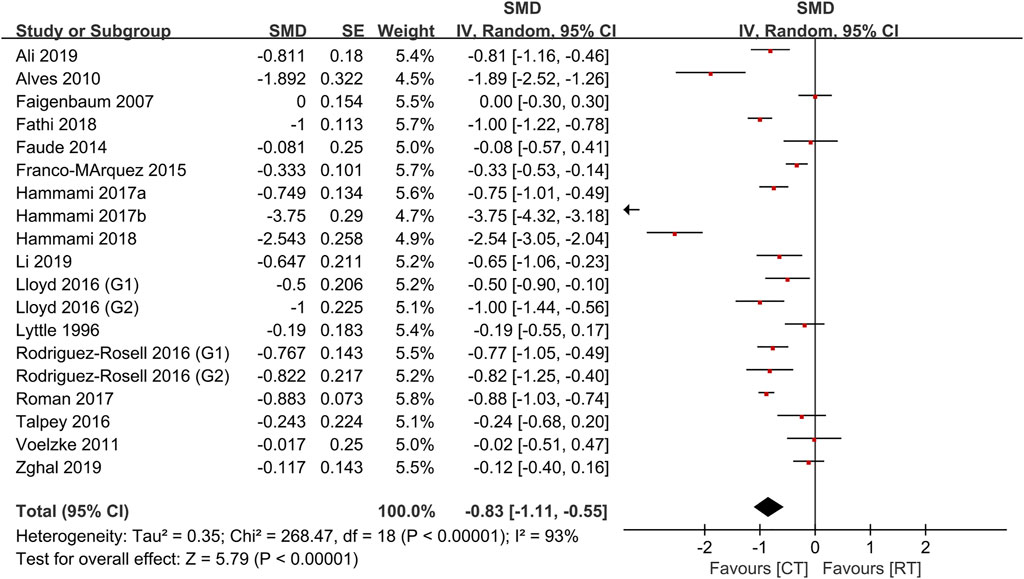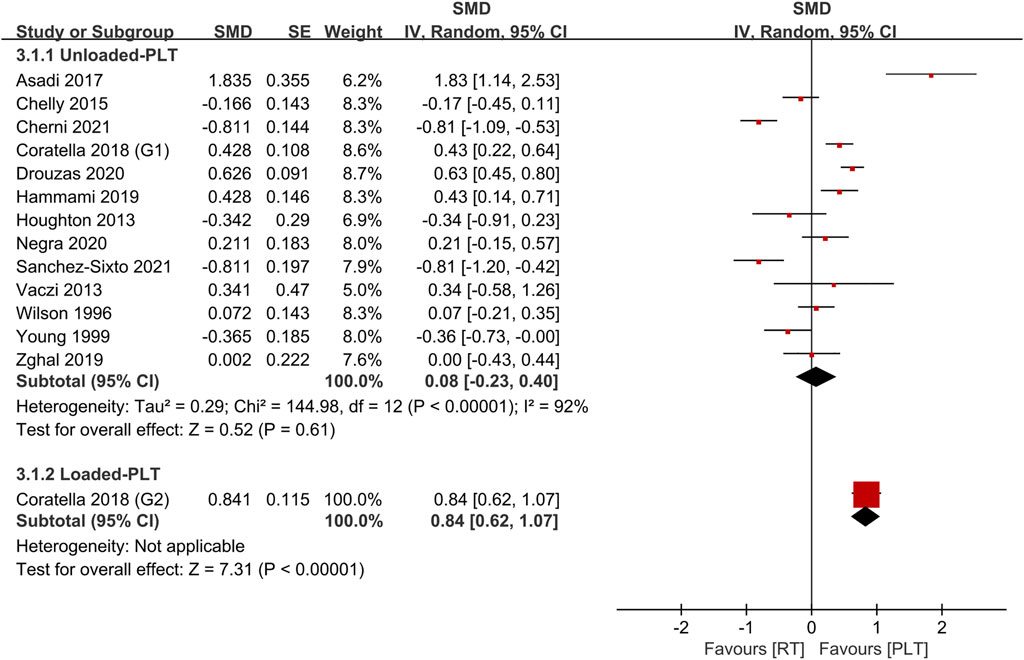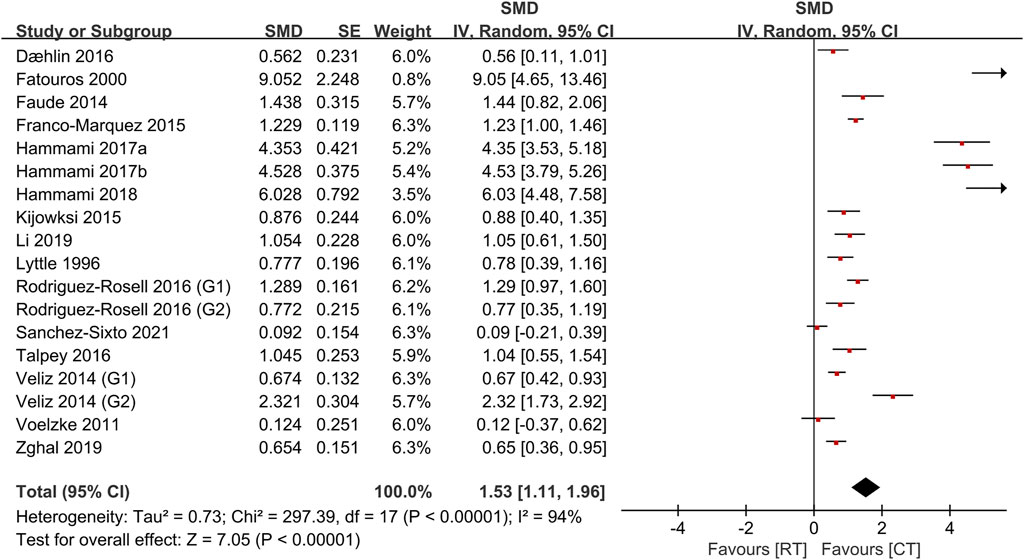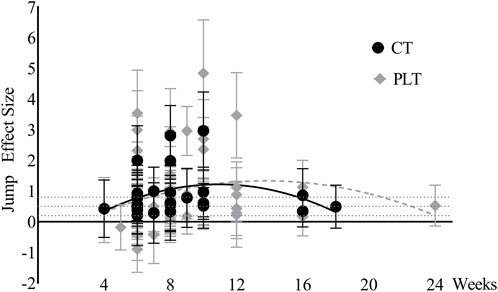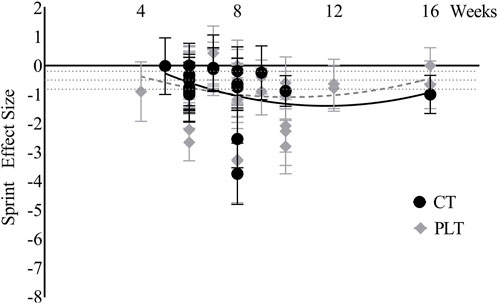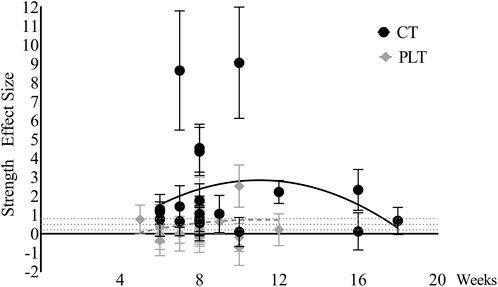- 1Department of Sport Studies, Faculty of Educational Studies, University Putra Malaysia, Serdang, Selangor, Malaysia
- 2Department of Physical Education, Shandong Technology and Business University, Yantai, Shandong, China
- 3Department of Sport Science, Kangwon National University, Chuncheon, South Korea
- 4Faculty of Educational Studies, Taizhou University, Taizhou, Zhejiang, China
- 5Department of Physical Education, Ludong University, Yantai, Shandong, China
Introduction: Explosive power is considered an important factor in competitive events. Thus, strategies such as complex training (CT) and plyometric training (PLT) are effective at improving explosive power. However, it is still not clear which of the two strategies can enable greater improvements on the explosive power. Thus, the aim of this systematic review was to compare the effects of PLT and CT on the explosive power of the lower limbs.
Methods: The Review Manager and GraphPad Prism programs were used to analyze the synthetic and time effects (effects over training time) on explosive power (i.e., jump ability, sprint ability) and maximum strength. Our research identified 87 studies comprising 1,355 subjects aged 10–26.4 years.
Results: The results suggested the following: 1) Synthetic effects on jump ability (Hedges’ g): .79 (p < .001) for unloaded PLT, 1.35 (p < .001) for loaded PLT and .85 (p < .001) for CT; 2) Synthetic effects on sprint ability: .83 (p < .001) for unloaded PLT, −2.11 (p < .001) for loaded PLT and −.78 (p < .001) for CT; 3) Synthetic effects on maximum strength: .84 (p < .001) for loaded PLT and 1.53 (p < .001) for CT; 4) The time effects of unloaded PLT and CT on explosive power were similar, but the time effects of CT on maximum strength were obviously above that of PLT.
Discussion: In conclusion, unloaded PLT and CT have a similar effect on explosive performance in the short term but loaded PLT has a better effect. The improvement of the maximum strength caused by CT was greater than that induced by PLT. In addition, more than 10 weeks of training may be more beneficial for the improvement of power. Therefore, for explosive power training, we suggest adopting unloaded or light-loaded PLT during a short season and applying CT during an annual or long training cycle.
Introduction
Explosive power is the ability to exert great muscular strength in a very short time (usually within 100 m) (Maffiuletti et al., 2016), which is vital for athletes to win the competition. Therefore, coaches and researchers have been concerned with how to select more efficient explosive training methods. Traditional resistance training (RT), plyometric training (PLT) and complex training (CT) have been widely used in strength and explosive training. The three training methods have different effects on explosive power. Traditional resistance training (RT) can increase athletes’ maximum strength but does not greatly increase explosive power because of the sticking point (Kompf and Arandjelović, 2016). When the joint reaches a certain angle in resistance motion, the muscle force will be minimized, and the movement speed will decrease, called the sticking zone (Kompf and Arandjelović, 2016). The reduction of force and speed is not conducive to the development of explosive force. Plyometric training (PLT), which follows the form of human movement, uses the principle of the “stretch-shortening cycle” (SSC) to transform the elastic potential energy in the eccentric contraction stage into kinetic energy in the concentric contraction stage (Ramirez-Campillo et al., 2020). It has a significant effect on the improvement of explosive power, but the low-load characteristic limits the improvement of maximum strength, and then the maximum force further limits the development of explosive power (Suchomel et al., 2016). Therefore, PLT may not be conducive to the long-term development of explosive power. Complex training (CT) combining RT and PLT uses postactivation potentiation (PAP) and stretch-shortening cycle (SSC) to enhance the explosive power and maximum strength of athletes (Carter and Greenwood, 2014) and seems to be a good choice for the improvement of explosive power. However, does CT improve explosive power better than PLT?
PLT and CT have better effects on the improvement of explosive power than TR (Behm et al., 2017; Pardos-Mainer et al., 2021; Morris et al., 2022). However, academic circles have not reached a consensus on whether CT is better than PLT in improving explosive power. Theoretically, CT integrates the advantages of PLT for the increasement of explosive power and RT for the enhancement of maximum strength, so as to improve the explosive power better. However, according to the force-velocity curve, there is an inverse relationship exists between force and velocity (Taber et al., 2016). Therefore, it is hard to improve both strength and speed (i.e., explosive power). Studies by Hammami et al. (2019); Zghal et al. (2019) showed that CT had better effects on improving jump ability, sprint ability and maximum strength than PLT, but some other studies showed that these two training methods had no significant difference in the improvement of jump performance (Arabatzi et al., 2010; da Silva Santos et al., 2015; Sánchez-Sixto et al., 2021). Lloyd et al. (2016) reported that there was no significant difference between these two training methods in improving the sprint ability of teenagers. We learned from previous research that PLT and CT have a significant effect on the improvement of explosive power. However, there is still great controversy concerning which training method is better.
Due to limited comparative studies (CT vs PLT), there have been no meta-analysis reviews conducted regarding the comparative effects of PLT and CT on explosive power. However, we used data from different experiments to conduct a meta-analysis by referring to Behm’s analysis method (Behm et al., 2017). In addition, we also compared the changes of the average effect size of the CT and PLT on explosive performance over time in order to display the research results more clearly. Therefore, the intent of this systematic review was to compare the effects of PLT and CT on explosive power. Because explosive power is strongly correlated with maximum strength (Taber et al., 2016), we also aim to compare the effects of CT and PLT on maximum strength. Another purpose was to provide clear guidelines for the prescription of explosive power training.
Methods
Experimental approach to the problem
This systematic review was conducted according to the Cochrane Collaboration Guidebook and the criteria of Preferred Reporting Elements for Systematic Reviews and Meta-analyses (Liberati et al., 2009).
Search strategy
Articles published by 10 June 2022, were located using the electronic databases PubMed, SCOPUS, SPORTDiscus, and Web of Science. The following search syntax was used (“randomized controlled trial” OR “controlled clinical trial”) [Publication Type] (“plyometric” OR “stretch-shortening cycle” OR “jump” OR “power” OR “complex” OR “compound” OR “combined”) AND (“training” OR “intervention”) [Title/Abstract]. Lead author’s personal libraries and gray literature sources (e.g., conference proceedings) were also examined. The systematic search process was conducted by JS and QX. Any disagreement of an included/excluded study was resolved by the third author (WX).
Eligibility Criteria
The inclusion criteria were as follows: 1) the study was randomized controlled trial or controlled trial. 2) The study employed a PLT or CT intervention inclusive of 2‒3 related exercises per week and more than a 4-week training duration. 3) The related indices of explosive power and maximum strength before and after training were measured in the study. The explosive power indices included jump ability (countermovement jump, squat jump, long jump, etc.) and sprint ability (10 m sprint or close distance sprint). The maximum strength indices included the one-repetition maximum (full squat, half squat, leg flexion and extension, etc.). 4) The subjects were healthy athletes or students with training experience, and their ages ranged from 10 to 30. Since this meta-analysis is not for comparative studies of the same experiment, sufficient sample size must be ensured to reduce errors. Therefore, we chose a wide age range (teenagers and young adults).
Exclusion criteria
Excluded records had the following: a) not available in English; b) non-human experiment; c) cross-sectional study; d) meta-analysis or review article; e) lack of data to calculate effect size (i.e., sample size, mean and standard deviation); and f) overtraining or distraining study. The screening flow chart is shown in Figure 1.
Data extraction
Data extraction from the included studies was independently performed by two authors (S.J. and X.M.). We extracted data from PLT- and CT-related studies. The following data were extracted: the first author’s name, publication year, sample size, subjects’ age (years), sex, training duration (weeks), training program, and outcome indicators (details in the Eligibility Criteria section). In instances where information was unavailable for the mean and standard deviation, lead authors were contacted for data. If no answer was received, the study was excluded. Any disagreement in data extraction was resolved by the third author (WX).
Statistical analyses
The Physiotherapy Evidence Database (PEDro) scale was used to assess the risk of all included studies. There are 11 items in the PEDro checklist for a total of 10 points (item 1 is not rated). As in a similar previous plyometric training meta-analysis, literature quality was interpreted as “low quality” (≤3 points), “medium quality” (4‒5 points), or “high quality” (6–10 points) (Stojanović et al., 2017). The results of the literature evaluation included in this study are shown in Table 1 and Table 2.
Effect sizes (Hedges’ g), standard error and 95% confidence interval were calculated by mean value and standard deviation. The pre-and post-experimental data of the experimental group were used for the analysis and calculation because of baseline differences between the experimental and control groups in the same study and differences in physical activity in control groups of different studies. Calculated effect sizes were interpreted using the following scale: .2–.5 = small, .5–.8 = moderate, > .8 = large (Stojanović et al., 2017). The effect sizes are usually positive, but sprint ability has negative effect sizes. This is because better sprint ability means less time to complete the same distance. The Review Manager Software (RevMan 5.3) was used to analyze the synthetic effects of PLT and CT on mechanistic changes (i.e., jump ability, sprint ability, and maximum strength), as well as the synthetic effects of the PLT subgroup (i.e., unloaded PLT and loaded PLT). We used the random-effects model to avoid the high weight of individual studies affecting the overall synthetic effect. In addition, GraphPad Prism Software (GraphPad Prism 8) was used to perform a linear fitting of mechanistic changes with time and compare the difference in the time effect between PLT and CT. Due to the limited data of loaded PT, we only compared the difference in the time effect between unloaded PLT and CT in this study.
Results
Study selection, characteristics, and risk of bias
In total, 60 PLT studies and 27 CT studies were included in this study, producing 143 and 63 effect sizes, respectively (Table 3). The included studies involved 996 PLT participants and 359 CT participants, with an average age range of 10–24.2 years and 9.7–26.4 years, respectively. The PLT program mainly included countermovement jump, squat jump, depth jump, long jump, hurdle jump, single- or double-legged jump, etc., and its training load was usually body weight and light weight (less than 25% extra body weight). The CT program mainly combines traditional resistance training (RT) (e.g., back squat, half squat, calf raise, leg flexion and extension, snatch and weight lifting, etc.) and PLT program. The load intensity of RT is usually 40%–95% of 1 RM. The shortest training duration was 4 weeks, and the longest training durations of PLT and CT were 24 weeks and 18 weeks, respectively. Among the included studies, most studies achieved 5‒6 points (medium-high quality), with the highest score achieving 9 points and the lowest score achieving 4 points. The PEDro scale score had a median of 5 of 10 points across studies (Tables 1, 2).
Synthetic results
Table 4 shows the comparative effects of PLT and CT on jump ability, sprint ability and maximum strength. In terms of effect sizes on jump ability, CT studies slightly exceeded unloaded PLT studies (.85, p < .001, large vs .79, p < .001, medium), but the loaded PLT showed the largest effect size (1.35, p < .001, large) (Figures 2, 3). In terms of effect sizes on sprint ability, unloaded PLT studies and CT studies showed the same effect size (−.83, p < .001, large), but the effect size of loaded PLT studies (−2.11, p < .001, large) was larger than that of unloaded PLT and CT studies (Figures 4, 5). In terms of effect sizes on maximum strength, both loaded and unloaded PLT studies were lower than CT studies, especially unloaded PLT studies with an effect size of .08 (Figures 6, 7).
Time effect fitting results
Time effects on jump ability. The time effects of PLT and CT on jump ability both increased at first and then decreased (Figure 8). Due to limited data after 12 weeks, we did not take into account trends thereafter. Before 10 weeks, the curves of the effect size of PLT and CT on jump ability were basically the same, with a large effect at week 6 for both, the peak effect at week 10 for CT and approximately week 10–12 for PLT.
Time effects on sprint ability. The curves of the effect size of PLT and CT on sprint ability are similar to those on jump ability (Figure 9). Before 10 weeks, the trends of the effect size of PLT and CT on sprint ability were basically the same, with a moderate effect at week 6 and a large effect at week 8 for both, a peak effect at week 8 for CT and week 10 for PLT.
Time effects on maximum strength. The effects of PLT on maximum strength only reached a large effect point at week 10, and the rest were below the medium effect (Figure 10). The effects of CT on maximum strength reached a large effect at week 6 and peaked at week 8, and then there was a downward trend. It should be noted that data after eight weeks were limited.
Discussion
This is the first meta-analysis review to compare the effects of PLT vs CT on the explosive power of the lower limbs. According to research findings, during the 10-week training period, the improvement in explosive power induced by unloaded PLT was similar to that caused by CT, but that induced by loaded PLT was better. In terms of maximum strength, the effect of CT was better than that of PLT. In addition, the time effect curves of PLT and CT on explosive power were basically consistent, with an ascending trend in 10 weeks.
It is interesting to note that unloaded PLT and CT demonstrated similar effects on the explosive power of the lower limbs in 10 weeks, which is different from some previous studies (Hammami et al., 2019; Zghal et al., 2019). In theory, CT should be better than PLT in improving explosive power because CT combines the postactivation potentiation (PAP) induced by high-intensity RT and the stretch-shortening cycle in PLT. However, that is not the case. There are several explanations that could underpin these findings. One reason is that PAP did not play its due effect or PAP is just a warm-up effect. High-intensity muscle contractions stimulate the central nervous system—leading to greater motor unit recruitment of the muscle during subsequent exercise—to increase neuromuscular force, a phenomenon referred to as PAP (Hilfiker et al., 2007). PAP is an acute response and therefore time-sensitive. The optimal PAP interval time between RT and PLT is 4–10 min (Jensen and Ebben, 2003; Jo et al., 2010). Most of interval time of the included studies in this review were shorter than this standard, and inadequate interval rest may result in PAP not working. In addition, Docherty and Hodgson (2007) believed that PAP was only a warm-up effect rather than a true chronic enhancement effect. Studies by Deutsch and Lloyd (2008) and Alemdaroglu et al. (2013) confirmed Dochert’s hypothesis. Their studies found no difference in the effect of different sequences of CT (RT followed by PLT or PLT followed by RT). This indirectly indicates that PAP does not play a significant role in CT.
The review also showed that the effects of CT on maximum strength significantly higher that of PLT. This is mainly because resistance training in CT increases the maximum muscle strength. The development of explosive power is based on maximum strength (Taber et al., 2016), so CT is the better strategy for developing explosive performance more than PLT in the long term. As for why there was no difference between the two training methods in the short term, another reason may be the combined effect of maximum strength and muscle fiber type. RT can reduce the proportion of IIx muscle fibers (fast glycolysis type) (Lamas et al., 2010), which is not conducive to the improvement of RFD, namely, the improvement of explosive power. While PLT can maintain the ratio of three muscle fibers (IIx, IIa, I), which can greatly improve RFD (Zaras et al., 2013). The ratio of muscle fibers induced by CT should be between that induced by PLT and RT. Therefore, it can be concluded that the performance of fast muscles induced by CT is weaker than that induced by PLT. However, the explosive power also depends on the level of maximum strength. The improvement of maximum strength makes up for the weakness of fast muscle performance in CT. Therefore, CT and PLT have similar effects on improving explosive power in the short term. However, for long-term explosive training, the improvement of explosive power by PLT will be limited due to the limitation of maximum strength. Therefore, CT is a more appropriate choice for developing explosive power in the long term.
In the subgroup analysis of this review, the effects of loaded PLT and CT on explosive power and maximum strength were compared. Although the data of loaded PLT are limited, it could still show that the improvement of explosive power caused by loaded PLT is significantly better than that caused by CT (jump ability: 1.35 vs .85; sprint ability: −2.11 vs. −.83). The extra weight during PLT will increase the inertia and ground reaction force during the SSC eccentric stage and the resistance at the SSC concentric stage, and this high-intensity stimulation can lead to better muscular adaptation for explosive power (Negra et al., 2020). In contrast, CT only provides high concentric resistance stimulation in the RT phase, while the SSC effect in the later PLT phase was in the non-weight-bearing state. As a result, the overall muscle adaptation of CT is slightly lower than that of loaded PLT, which well explains the superiority of loaded PLT in the improvement of explosive power. However, loaded PLT also has drawbacks. The premise of the optimal effect of SSC is the rapid connection between eccentric and concentric stages. If the connection time is too long or the motion range of the joint is too large, the more elastic potential energy will be lost in the form of heat energy, thus weakening the SSC effect (Komi, 2003). At present, there is no consensus on the optimal extra load for PLT. However, according to the existing research data, no sports injury was found in loaded PLT with 0%–25% extra body weight (Rosas et al., 2016; Coratella et al., 2018; Negra et al., 2020). It is suggested that coaches should choose the PLT load carefully according to the specific situation of the athlete.
In terms of time effects, the effect curves of unloaded PLT and CT on explosive power (jump ability and sprint ability) are basically consistent and with an ascending trend in 10 weeks. This proved again unloaded PLT and CT have similar effect on explosive power and showed that more than 10 weeks of training may be beneficial for the development of explosive power. In general, Low load training while maintaining intensity is recommended during a short season because it does not create much training fatigue and affect competition performance (Zhou and Zhang, 2017). Therefore, unloaded PLT is suitable for explosive training in a short season. While long-term explosive training is based on maximum strength, CT is more suitable for annual training or long training cycles.
Conclusion
The findings of this review suggests that unloaded PLT and CT have a similar significant effect on explosive performance (jump ability, sprint ability) in short term (within 10 weeks), but loaded PLT has a better effect. Furthermore, CT has significant beneficial effect on maximum strength compared to PLT. Therefore, we suggest applying unloaded or light-loaded PLT for explosive training in short season and applying CT in an annual or long training cycle. In addition, more than 10 weeks of training may be more beneficial for the improvement of power.
Data availability statement
The original contributions presented in the study are included in the article/Supplementary Material, further inquiries can be directed to the corresponding author.
Author contributions
XW and CL have given substantial contributions to the conception or the design of the manuscript, XQ, SJ, and DD to acquisition, analysis and interpretation of the data. XW drafted the manuscript, and CL revised it critically. All authors read and approved the final version of the manuscript.
Conflict of interest
The authors declare that the research was conducted in the absence of any commercial or financial relationships that could be construed as a potential conflict of interest.
Publisher’s note
All claims expressed in this article are solely those of the authors and do not necessarily represent those of their affiliated organizations, or those of the publisher, the editors and the reviewers. Any product that may be evaluated in this article, or claim that may be made by its manufacturer, is not guaranteed or endorsed by the publisher.
References
Alemdaroglu U., Dündar U., Köklü Y., Aşci A., Findikoğlu G. (2013). The effect of exercise order incorporating plyometric and resistance training on isokinetic leg strength and vertical jump performance: A comparative study. Isokinet. Exerc. Sci. 21 (3), 211–217. doi:10.3233/ies-130509
Ali K., Verma S., Ahmad I., Singla D., Saleem M., Hussain M. E. (2019). Comparison of complex versus contrast training on steroid hormones and sports performance in male soccer players. J. Chiropr. Med. 18 (2), 131–138. doi:10.1016/j.jcm.2018.12.001
Aloui G., Hermassi S., Hayes L. D., Bouhafs E. G., Chelly M. S., Schwesig R. (2021). Loaded plyometrics and short sprints with change-of-direction training enhance jumping, sprinting, agility, and balance performance of male soccer players. Appl. Sci. 11 (12), 5587. doi:10.3390/app11125587
Alves J. M. V. M., Rebelo A. N., Abrantes C., Sampaio J. (2010). Short-term effects of complex and contrast training in soccer players' vertical jump, sprint, and agility abilities. J. Strength & Cond. Res. 24 (4), 936–941. doi:10.1519/JSC.0b013e3181c7c5fd
Arabatzi F., Kellis E., De Villarreal E. S.-S. (2010). Vertical jump biomechanics after plyometric, weight lifting, and combined (weight lifting+ plyometric) training. J. Strength & Cond. Res. 24 (9), 2440–2448. doi:10.1519/JSC.0b013e3181e274ab
Asadi A., Ramirez-Campillo R., Arazi H., Sáez de Villarreal E. (2018). The effects of maturation on jumping ability and sprint adaptations to plyometric training in youth soccer players. J. sports Sci. 36 (21), 2405–2411. doi:10.1080/02640414.2018.1459151
Asadi A., Ramirez-Campillo R., Meylan C., Nakamura F. Y., Cañas-Jamett R., Izquierdo M. (2016). Effects of volume-based overload plyometric training on maximal-intensity exercise adaptations in young basketball players. J. sports Med. Phys. Fit. 57 (12), 1557–1563. doi:10.23736/S0022-4707.16.06640-8
Behm D. G., Young J. D., Whitten J. H., Reid J. C., Quigley P. J., Low J., et al. (2017). Effectiveness of traditional strength vs. power training on muscle strength, power and speed with youth: A systematic review and meta-analysis. Front. Physiology 8, 423. doi:10.3389/fphys.2017.00423
Blattner S. E., Noble L. (1979). Relative effects of isokinetic and plyometric training on vertical jumping performance. Res. Q. Am. Alliance Health, Phys. Educ. Recreat. Dance 50 (4), 583–588. doi:10.1080/00345377.1979.10615653
Campo S. S., Vaeyens R., Philippaerts R. M., Redondo J. C., de Benito A. M., Cuadrado G. (2009). Effects of lower-limb plyometric training on body composition, explosive strength, and kicking speed in female soccer players. J. Strength & Cond. Res. 23 (6), 1714–1722. doi:10.1519/JSC.0b013e3181b3f537
Carlson K., Magnusen M., Walters P. (2009). Effect of various training modalities on vertical jump. Res. Sports Med. 17 (2), 84–94. doi:10.1080/15438620902900351
Carter J., Greenwood M. (2014). Complex training reexamined: Review and recommendations to improve strength and power. Strength & Cond. J. 36 (2), 11–19. doi:10.1519/ssc.0000000000000036
Chelly M. S., Ghenem M. A., Abid K., Hermassi S., Tabka Z., Shephard R. J. (2010). Effects of in-season short-term plyometric training program on leg power, jump-and sprint performance of soccer players. J. Strength & Cond. Res. 24 (10), 2670–2676. doi:10.1519/JSC.0b013e3181e2728f
Chelly M. S., Hermassi S., Aouadi R., Shephard R. J. (2014). Effects of 8-week in-season plyometric training on upper and lower limb performance of elite adolescent handball players. J. Strength & Cond. Res. 28 (5), 1401–1410. doi:10.1519/JSC.0000000000000279
Chelly M. S., Hermassi S., Shephard R. J. (2015). Effects of in-season short-term plyometric training program on sprint and jump performance of young male track athletes. J. Strength & Cond. Res. 29 (8), 2128–2136. doi:10.1519/JSC.0000000000000860
Cherni Y., Hammami M., Jelid M. C., Aloui G., Suzuki K., Shephard R. J., et al. (2021). Neuromuscular adaptations and enhancement of physical performance in female basketball players after 8 weeks of plyometric training. Front. Physiology 11, 588787. doi:10.3389/fphys.2020.588787
Chtara M., Rouissi M., Haddad M., Chtara H., Chaalali A., Owen A., et al. (2017). Specific physical trainability in elite young soccer players: Efficiency over 6 weeks’ in-season training. Biol. sport 34 (2), 137–148. doi:10.5114/biolsport.2017.64587
Coratella G., Beato M., Milanese C., Longo S., Limonta E., Rampichini S., et al. (2018). Specific adaptations in performance and muscle architecture after weighted jump-squat vs. body mass squat jump training in recreational soccer players. J. Strength & Cond. Res. 32 (4), 921–929. doi:10.1519/JSC.0000000000002463
da Silva Santos J. F., Valenzuela T. H., Franchini E. J. T. J. o. S., Research C. (2015). Can different conditioning activities and rest intervals affect the acute performance of taekwondo turning kick? J. Strength Cond. Res. 29 (6), 1640–1647. doi:10.1519/JSC.0000000000000808
Daehlin T., Haugen O., Haugerud S., Hollan I., Raastad T., Ronnestad B. (2016). Combined plyometric & strength training improves ice-hockey players’ on-ice sprint. Int. J. Sports Physiol. Perform., 1–22.
de Villarreal E. S., Suarez-Arrones L., Requena B., Haff G. G., Ferrete C. (2015). Effects of plyometric and sprint training on physical and technical skill performance in adolescent soccer players. J. Strength & Cond. Res. 29 (7), 1894–1903. doi:10.1519/JSC.0000000000000838
Dello Iacono A., Martone D., Milic M., Padulo J. (2017). Vertical-vs. Horizontal-oriented drop jump training: Chronic effects on explosive performances of elite handball players. J. strength Cond. Res. 31 (4), 921–931. doi:10.1519/JSC.0000000000001555
Deutsch M., Lloyd R. (2008). Effect of order of exercise on performance during a complex training session in rugby players. J. sports Sci. 26 (8), 803–809. doi:10.1080/02640410801942130
Docherty D., Hodgson M. J. (2007). The application of postactivation potentiation to elite sport. Int. J. Sports Physiology Perform. 2 (4), 439–444. doi:10.1123/ijspp.2.4.439
Drouzas V., Katsikas C., Zafeiridis A., Jamurtas A. Z., Bogdanis G. C. (2020). Unilateral plyometric training is superior to volume-matched bilateral training for improving strength, speed and power of lower limbs in preadolescent soccer athletes. J. Hum. Kinet. 74 (1), 161–176. doi:10.2478/hukin-2020-0022
Faigenbaum A. D., McFarland J. E., Keiper F. B., Tevlin W., Ratamess N. A., Kang J., et al. (2007). Effects of a short-term plyometric and resistance training program on fitness performance in boys age 12 to 15 years. J. sports Sci. Med. 6 (4), 519–525.
Fathi A., Hammami R., Moran J., Borji R., Sahli S., Rebai H. (2019). Effect of a 16-week combined strength and plyometric training program followed by a detraining period on athletic performance in pubertal volleyball players. J. Strength & Cond. Res. 33 (8), 2117–2127. doi:10.1519/JSC.0000000000002461
Fatouros I. G., Jamurtas A. Z., Leontsini D., Taxildaris K., Aggelousis N., Kostopoulos N., et al. (2000). Evaluation of plyometric exercise training, weight training, and their combination on vertical jumping performance and leg strength. J. Strength & Cond. Res. 14 (4), 470–476. doi:10.1519/00124278-200011000-00016
Faude O., Roth R., Di Giovine D., Zahner L., Donath L. (2013). Combined strength and power training in high-level amateur football during the competitive season: A randomised-controlled trial. J. sports Sci. 31 (13), 1460–1467. doi:10.1080/02640414.2013.796065
Fernandez-Fernandez J., De Villarreal E. S., Sanz-Rivas D., Moya M. (2016). The effects of 8-week plyometric training on physical performance in young tennis players. Pediatr. Exerc. Sci. 28 (1), 77–86. doi:10.1123/pes.2015-0019
Franco-Márquez F., Rodríguez-Rosell D., González-Suárez J. M., Pareja-Blanco F., Mora-Custodio R., Yañez-García J., et al. (2015). Effects of combined resistance training and plyometrics on physical performance in young soccer players. Int. J. Sports Med. 94 (11), 906–914. doi:10.1055/s-0035-1548890
Gehri D. J., Ricard M. D., Kleiner D. M., Kirkendall D. T. (1998). A comparison of plyometric training techniques for improving vertical jump ability and energy production. J. strength Cond. Res. 12, 85–89. doi:10.1519/1533-4287(1998)012<0085:acoptt>2.3.co;2
González-Ravé J. M., Naclerio F., Parrilla I., Amores I. Y., González-Mohíno F. (2019). Adaptations of short-term high-velocity isokinetic training vs. short-term plyometric training on vertical jump and isokinetic performance in physically active people. Isokinet. Exerc. Sci. 27 (2), 117–123. doi:10.3233/ies-192107
Hall E., Bishop D. C., Gee T. I. (2016). Effect of plyometric training on handspring vault performance and functional power in youth female gymnasts. PloS one 11 (2), e0148790. doi:10.1371/journal.pone.0148790
Hammami M., Gaamouri N., Shephard R. J., Chelly M. S. (2019). Effects of contrast strength vs. plyometric training on lower-limb explosive performance, ability to change direction and neuromuscular adaptation in soccer players. J. Strength & Cond. Res. 33 (8), 2094–2103. doi:10.1519/JSC.0000000000002425
Hammami M., Gaamouri N., Suzuki K., Aouadi R., Shephard R. J., Chelly M. S. (2020a). Effects of unloaded vs. ankle-loaded plyometric training on the physical fitness of U-17 male soccer players. Int. J. Environ. Res. Public Health 17 (21), 7877. doi:10.3390/ijerph17217877
Hammami M., Gaamouri N., Suzuki K., Shephard R. J., Chelly M. S. (2020b). Effects of upper and lower limb plyometric training program on components of physical performance in young female handball players. Front. Physiology 11, 1028. doi:10.3389/fphys.2020.01028
Hammami M., Negra Y., Aouadi R., Shephard R. J., Chelly M. S. (2016). Effects of an in-season plyometric training program on repeated change of direction and sprint performance in the junior soccer player. J. Strength & Cond. Res. 30 (12), 3312–3320. doi:10.1519/JSC.0000000000001470
Hammami M., Negra Y., Shephard R. J., Chelly M.-S. (2017a). Effects of leg contrast strength training on sprint, agility and repeated change of direction performance in male soccer players. J. sports Med. Phys. Fit. 57 (11), 1424–1431. doi:10.23736/S0022-4707.17.06951-1
Hammami M., Negra Y., Shephard R. J., Chelly M. S. (2017b). The effect of standard strength vs. contrast strength training on the development of sprint, agility, repeated change of direction, and jump in junior male soccer players. J. strength Cond. Res. 31 (4), 901–912. doi:10.1519/JSC.0000000000001815
Hilfiker R., Hübner K., Lorenz T., Marti B. (2007). Effects of drop jumps added to the warm-up of elite sport athletes with a high capacity for explosive force development. J. strength Cond. Res. 21 (2), 550–555. doi:10.1519/R-20215.1
Houghton L. A., Dawson B. T., Rubenson J. (2013). Effects of plyometric training on achilles tendon properties and shuttle running during a simulated cricket batting innings. J. Strength & Cond. Res. 27 (4), 1036–1046. doi:10.1519/JSC.0b013e3182651e7a
Idrizovic K., Gjinovci B., Sekulic D., Uljevic O., João P. V., Spasic M., et al. (2018). The effects of 3-month skill-based and plyometric conditioning on fitness parameters in junior female volleyball players. Pediatr. Exerc. Sci. 30 (3), 353–363. doi:10.1123/pes.2017-0178
Jensen R. L., Ebben W. P. (2003). Kinetic analysis of complex training rest interval effect on vertical jump performance. J. Strength & Cond. Res. 17 (2), 345–349. doi:10.1519/1533-4287(2003)017<0345:kaoctr>2.0.co;2
Jlid M. C., Coquart J., Maffulli N., Paillard T., Bisciotti G. N., Chamari K. (2020). Effects of in season multi-directional plyometric training on vertical jump performance, change of direction speed and dynamic postural control in U-21 soccer Players. Front. Physiology 11, 374. doi:10.3389/fphys.2020.00374
Jlid M. C., Racil G., Coquart J., Paillard T., Bisciotti G. N., Chamari K. (2019). Multidirectional plyometric training: Very efficient way to improve vertical jump performance, change of direction performance and dynamic postural control in young soccer players. Front. Physiology 10, 1462. doi:10.3389/fphys.2019.01462
Jo E., Judelson D. A., Brown L. E., Coburn J. W., Dabbs N. C. (2010). Influence of recovery duration after a potentiating stimulus on muscular power in recreationally trained individuals. J. Strength & Cond. Res. 24 (2), 343–347. doi:10.1519/JSC.0b013e3181cc22a4
Karadenizli Z. I. (2016). The effects of plyometric training on balance, anaerobic power and physical fitness parameters in handball. Anthropol. 24 (3), 751–761. doi:10.1080/09720073.2016.11892072
Kato T., Terashima T., Yamashita T., Hatanaka Y., Honda A., Umemura Y. (2006). Effect of low-repetition jump training on bone mineral density in young women. J. Appl. physiology 100 (3), 839–843. doi:10.1152/japplphysiol.00666.2005
Khlifa R., Aouadi R., Hermassi S., Chelly M. S., Jlid M. C., Hbacha H., et al. (2010). Effects of a plyometric training program with and without added load on jumping ability in basketball players. J. Strength & Cond. Res. 24 (11), 2955–2961. doi:10.1519/JSC.0b013e3181e37fbe
Khodaei K., Mohammadi A., Badri N. (2017). A comparison of assisted, resisted, and common plyometric training modes to enhance sprint and agility performance. J. sports Med. Phys. Fit. 57 (10), 1237–1244. doi:10.23736/S0022-4707.17.06901-8
Kijowksi K. N., Capps C. R., Goodman C. L., Erickson T. M., Knorr D. P., Triplett N. T., et al. (2015). Short-term resistance and plyometric training improves eccentric phase kinetics in jumping. J. Strength & Cond. Res. 29 (8), 2186–2196. doi:10.1519/JSC.0000000000000904
Kobal R., Pereira L. A., Zanetti V., Ramirez-Campillo R., Loturco I. (2017). Effects of unloaded vs. loaded plyometrics on speed and power performance of elite young soccer players. Front. Physiology 8, 742. doi:10.3389/fphys.2017.00742
Komi P. V. (2003). Stretch-shortening cycle. Strength power sport 2, 184–202. doi:10.1002/9780470757215.ch10
Kompf J., Arandjelović O. (2016). Understanding and overcoming the sticking point in resistance exercise. Sports Med. 46 (6), 751–762. doi:10.1007/s40279-015-0460-2
Lamas L., Aoki M. S., Ugrinowitsch C., Campos G., Regazzini M., Moriscot A. S., et al. (2010). Expression of genes related to muscle plasticity after strength and power training regimens. Scand. J. Med. Sci. sports 20 (2), 216–225. doi:10.1111/j.1600-0838.2009.00905.x
Latorre Román P. Á., Villar Macias F. J., García Pinillos F. (2018). Effects of a contrast training programme on jumping, sprinting and agility performance of prepubertal basketball players. J. sports Sci. 36 (7), 802–808. doi:10.1080/02640414.2017.1340662
Li F., Wang R., Newton R. U., Sutton D., Shi Y., Ding H. (2019). Effects of complex training versus heavy resistance training on neuromuscular adaptation, running economy and 5-km performance in well-trained distance runners. PeerJ 7, e6787. doi:10.7717/peerj.6787
Liberati A., Altman D. G., Tetzlaff J., Mulrow C., Gøtzsche P. C., Ioannidis J. P., et al. (2009). The PRISMA statement for reporting systematic reviews and meta-analyses of studies that evaluate health care interventions: Explanation and elaboration. J. Clin. Epidemiol. 62 (10), e1–e34. doi:10.1016/j.jclinepi.2009.06.006
Lloyd R. S., Radnor J. M., Croix M. B. D. S., Cronin J. B., Oliver J. L. (2016). Changes in sprint and jump performances after traditional, plyometric, and combined resistance training in male youth pre-and post-peak height velocity. J. Strength & Cond. Res. 30 (5), 1239–1247. doi:10.1519/JSC.0000000000001216
Lyttle A. D., Wilson G. J., Ostrowski K. J. J. J. o. s., research c. (1996). Enhancing performance: Maximal power versus combined weights and plyometrics training. J. strength Cond. Res. 10, 173–179. doi:10.1519/1533-4287(1996)010<0173:epmpvc>2.3.co;2
Maciejczyk M., Błyszczuk R., Drwal A., Nowak B., Strzała M. (2021). Effects of short-term plyometric training on agility, jump and repeated sprint performance in female soccer players. Int. J. Environ. Res. Public Health 18 (5), 2274. doi:10.3390/ijerph18052274
Maffiuletti N. A., Aagaard P., Blazevich A. J., Folland J., Tillin N., Duchateau J. (2016). Rate of force development: Physiological and methodological considerations. Eur. J. Appl. physiology 116 (6), 1091–1116. doi:10.1007/s00421-016-3346-6
Makaruk H., Czaplicki A., Sacewicz T., Sadowski J. (2014). The effects of single versus repeated plyometrics on landing biomechanics and jumping performance in men. Biol. sport 31 (1), 9–14. doi:10.5604/20831862.1083273
Mazurek K., Zmijewski P., Makaruk H., Mróz A., Czajkowska A., Witek K., et al. (2018). Effects of short-term plyometric training on physical performance in male handball players. J. Hum. Kinet. 63 (1), 137–148. doi:10.2478/hukin-2018-0014
McKinlay B. J., Wallace P., Dotan R., Long D., Tokuno C., Gabriel D. A., et al. (2018). Effects of plyometric and resistance training on muscle strength, explosiveness, and neuromuscular function in young adolescent soccer players. J. Strength & Cond. Res. 32 (11), 3039–3050. doi:10.1519/JSC.0000000000002428
Meszler B., Váczi M. (2019). Effects of short-term in-season plyometric training in adolescent female basketball players. Physiol. Int. 106 (2), 168–179. doi:10.1556/2060.106.2019.14
Morris S. J., Oliver J. L., Pedley J. S., Haff G. G., Lloyd R. S. (2022). Comparison of weightlifting, traditional resistance training and plyometrics on strength, power and speed: A systematic review with meta-analysis. Sports Med. 52, 1533–1554. doi:10.1007/s40279-021-01627-2
Negra Y., Chaabene H., Fernandez-Fernandez J., Sammoud S., Bouguezzi R., Prieske O., et al. (2020a). Short-term plyometric jump training improves repeated-sprint ability in prepuberal male soccer players. J. Strength & Cond. Res. 34 (11), 3241–3249. doi:10.1519/JSC.0000000000002703
Negra Y., Chaabene H., Sammoud S., Bouguezzi R., Abbes M. A., Hachana Y., et al. (2017). Effects of plyometric training on physical fitness in prepuberal soccer athletes. Int. J. Sports Med. 38 (05), 370–377. doi:10.1055/s-0042-122337
Negra Y., Chaabene H., Sammoud S., Prieske O., Moran J., Ramirez-Campillo R., et al. (2020). The increased effectiveness of loaded versus unloaded plyometric jump training in improving muscle power, speed, change of direction, and kicking-distance performance in prepubertal male soccer players. Int. J. sports physiology Perform. 15 (2), 189–195. doi:10.1123/ijspp.2018-0866
Negra Y., Chaabene H., Stöggl T., Hammami M., Chelly M. S., Hachana Y. (2020b). Effectiveness and time-course adaptation of resistance training vs. plyometric training in prepubertal soccer players. J. Sport Health Sci. 9 (6), 620–627. doi:10.1016/j.jshs.2016.07.008
Ozbar N., Ates S., Agopyan A. (2014). The effect of 8-week plyometric training on leg power, jump and sprint performance in female soccer players. J. Strength & Cond. Res. 28 (10), 2888–2894. doi:10.1519/JSC.0000000000000541
Ozbar N. (2015). Effects of plyometric training on explosive strength, speed and kicking speed in female soccer players. Anthropol. 19 (2), 333–339. doi:10.1080/09720073.2015.11891666
Palma-Muñoz I., Ramírez-Campillo R., Azocar-Gallardo J., Álvarez C., Asadi A., Moran J., et al. (2021). Effects of progressed and nonprogressed volume-based overload plyometric training on components of physical fitness and body composition variables in youth male basketball players. J. Strength & Cond. Res. 35 (6), 1642–1649. doi:10.1519/JSC.0000000000002950
Pardos-Mainer E., Lozano D., Torrontegui-Duarte M., Cartón-Llorente A., Roso-Moliner A. (2021). Effects of strength vs. plyometric training programs on vertical jumping, linear sprint and change of direction speed performance in female soccer players: A systematic review and meta-analysis. Int. J. Environ. Res. Public Health 18 (2), 401. doi:10.3390/ijerph18020401
Pereira A., M Costa A., Santos P., Figueiredo T., Vicente João P. (2015). Training strategy of explosive strength in young female volleyball players. Medicina 51 (2), 126–131. doi:10.1016/j.medici.2015.03.004
Ramirez Campillo R., Moran J., Chaabene H., Granacher U., Behm D. G., García-Hermoso A., et al. (2020). Methodological characteristics and future directions for plyometric jump training research. A scoping Rev. update 30 (6), 983–997.
Ramirez-Campillo R., Alvarez C., García-Pinillos F., Gentil P., Moran J., Pereira L. A., et al. (2019). Effects of plyometric training on physical performance of young male soccer players: Potential effects of different drop jump heights. Pediatr. Exerc. Sci. 31 (3), 306–313. doi:10.1123/pes.2018-0207
Ramirez-Campillo R., García-Pinillos F., García-Ramos A., Yanci J., Gentil P., Chaabene H., et al. (2018). Effects of different plyometric training frequencies on components of physical fitness in amateur female soccer players. Front. Physiology 9, 934. doi:10.3389/fphys.2018.00934
Ramírez-Campillo R., Vergara-Pedreros M., Henríquez-Olguín C., Martínez-Salazar C., Alvarez C., Nakamura F. Y., et al. (2016). Effects of plyometric training on maximal-intensity exercise and endurance in male and female soccer players. J. sports Sci. 34 (8), 687–693. doi:10.1080/02640414.2015.1068439
Rodríguez-Rosell D., Franco-Márquez F., Pareja-Blanco F., Mora-Custodio R., Yáñez-García J. M., González-Suárez J. M., et al. (2016). Effects of 6 weeks resistance training combined with plyometric and speed exercises on physical performance of pre-peak-height-velocity soccer players. Int. J. sports physiology Perform. 11 (2), 240–246. doi:10.1123/ijspp.2015-0176
Rodríguez-Rosell D., Torres-Torrelo J., Franco-Márquez F., González-Suárez J. M., González-Badillo J. J. (2017). Effects of light-load maximal lifting velocity weight training vs. combined weight training and plyometrics on sprint, vertical jump and strength performance in adult soccer players. J. Sci. Med. sport 20 (7), 695–699. doi:10.1016/j.jsams.2016.11.010
Rosas F., Ramirez-Campillo R., Diaz D., Abad-Colil F., Martinez-Salazar C., Caniuqueo A., et al. (2016). Jump training in youth soccer players: Effects of haltere type handheld loading. Int. J. Sports Med. 37 (13), 1060–1065. doi:10.1055/s-0042-111046
Rosas F., Ramírez-Campillo R., Martínez C., Caniuqueo A., Cañas-Jamet R., McCrudden E., et al. (2017). Effects of plyometric training and beta-alanine supplementation on maximal-intensity exercise and endurance in female soccer players. J. Hum. Kinet. 58 (1), 99–109. doi:10.1515/hukin-2017-0072
Rubley M. D., Haase A. C., Holcomb W. R., Girouard T. J., Tandy R. D. (2011). The effect of plyometric training on power and kicking distance in female adolescent soccer players. J. Strength & Cond. Res. 25 (1), 129–134. doi:10.1519/JSC.0b013e3181b94a3d
Sammoud S., Negra Y., Bouguezzi R., Hachana Y., Granacher U., Chaabene H. (2021). The effects of plyometric jump training on jump and sport-specific performances in prepubertal female swimmers. J. Exerc. Sci. Fit. 19 (1), 25–31. doi:10.1016/j.jesf.2020.07.003
Sánchez-Sixto A., Harrison A. J., Floría P. (2021). Effects of plyometric vs. Combined plyometric training on vertical jump biomechanics in female basketball players. J. Hum. Kinet. 77 (1), 25–35. doi:10.2478/hukin-2021-0009
Santos E. J., Janeira M. A. (2008). Effects of complex training on explosive strength in adolescent male basketball players. J. Strength & Cond. Res. 22 (3), 903–909. doi:10.1519/JSC.0b013e31816a59f2
Söhnlein Q., Müller E., Stöggl T. L. (2014). The effect of 16-week plyometric training on explosive actions in early to mid-puberty elite soccer players. J. Strength & Cond. Res. 28 (8), 2105–2114. doi:10.1519/JSC.0000000000000387
Stojanović E., Ristić V., McMaster D. T., Milanović Z. (2017). Effect of plyometric training on vertical jump performance in female athletes: A systematic review and meta-analysis. Sports Med. 47 (5), 975–986. doi:10.1007/s40279-016-0634-6
Suchomel T. J., Nimphius S., Stone M. H. (2016). The importance of muscular strength in athletic performance. Sports Med. 46 (10), 1419–1449. doi:10.1007/s40279-016-0486-0
Taber C., Bellon C., Abbott H., Bingham G. E. J. S., Journal C. (2016). Roles of maximal strength and rate of force development in maximizing muscular power. Strength & Cond. J. 38 (1), 71–78. doi:10.1519/ssc.0000000000000193
Talpey S. W., Young W. B., Saunders N. (2016). Is nine weeks of complex training effective for improving lower body strength, explosive muscle function, sprint and jumping performance? Int. J. Sports Sci. Coach. 11 (5), 736–745. doi:10.1177/1747954116667112
Teo S. Y., Newton M. J., Newton R. U., Dempsey A. R., Fairchild T. J. (2016). Comparing the effectiveness of a short-term vertical jump vs. weightlifting program on athletic power development. J. strength Cond. Res. 30 (10), 2741–2748. doi:10.1519/JSC.0000000000001379
Váczi M., Tollár J., Meszler B., Juhász I., Karsai I. (2013). Short-term high intensity plyometric training program improves strength, power and agility in male soccer players. J. Hum. Kinet. 36, 17–26. doi:10.2478/hukin-2013-0002
Veliz R. R., Requena B., Suarez-Arrones L., Newton R. U., De Villarreal E. S. (2014). Effects of 18-week in-season heavy-resistance and power training on throwing velocity, strength, jumping, and maximal sprint swim performance of elite male water polo players. J. Strength & Cond. Res. 28 (4), 1007–1014. doi:10.1519/JSC.0000000000000240
Veliz R. R., Suarez-Arrones L., Requena B., Haff G. G., Feito J., de Villarreal E. S. (2015). Effects of in-competitive season power-oriented and heavy resistance lower-body training on performance of elite female water polo players. J. Strength & Cond. Res. 29 (2), 458–465. doi:10.1519/JSC.0000000000000643
Vera-Assaoka T., Ramirez-Campillo R., Alvarez C., Garcia-Pinillos F., Moran J., Gentil P., et al. (2020). Effects of maturation on physical fitness adaptations to plyometric drop jump training in male youth soccer players. J. Strength & Cond. Res. 34 (10), 2760–2768. doi:10.1519/JSC.0000000000003151
Voelzke M., Stutzig N., Thorhauer H.-A., Granacher U. (2012). Promoting lower extremity strength in elite volleyball players: Effects of two combined training methods. J. Sci. Med. sport 15 (5), 457–462. doi:10.1016/j.jsams.2012.02.004
Whitehead M. T., Scheett T. P., McGuigan M. R., Martin A. V. (2018). A comparison of the effects of short-term plyometric and resistance training on lower-body muscular performance. J. Strength & Cond. Res. 32 (10), 2743–2749. doi:10.1519/JSC.0000000000002083
Wilson G. J., Murphy A. J., Giorgi A. (1996). Weight and plyometric training: Effects on eccentric and concentric force production. Can. J. Appl. Physiology 21 (4), 301–315. doi:10.1139/h96-026
Yanci J., Castillo D., Iturricastillo A., Ayarra R., Nakamura F. Y. (2017). Effects of two different volume-equated weekly distributed short-term plyometric training programs on futsal players' physical performance. J. Strength & Cond. Res. 31 (7), 1787–1794. doi:10.1519/JSC.0000000000001644
Young W., Wilson C., Byrne C. (1999). A comparison of drop jump training methods: Effects on leg extensor strength qualities and jumping performance. Int. J. Sports Med. 20 (05), 295–303. doi:10.1055/s-2007-971134
Zaras N., Spengos K., Methenitis S., Papadopoulos C., Karampatsos G., Georgiadis G., et al. (2013). Effects of strength vs. ballistic-power training on throwing performance. J. sports Sci. Med. 12 (1), 130–137.
Zghal F., Colson S. S., Blain G., Behm D. G., Granacher U., Chaouachi A. (2019). Combined resistance and plyometric training is more effective than plyometric training alone for improving physical fitness of pubertal soccer players. Front. Physiology 10, 1026. doi:10.3389/fphys.2019.01026
Keywords: plyometric exercises, complex exercises, resistance training, explosive force, muscular strength
Citation: Wang X, Lv C, Qin X, Ji S and Dong D (2023) Effectiveness of plyometric training vs. complex training on the explosive power of lower limbs: A Systematic review. Front. Physiol. 13:1061110. doi: 10.3389/fphys.2022.1061110
Received: 04 October 2022; Accepted: 27 December 2022;
Published: 18 January 2023.
Edited by:
Souhail Hermassi, Qatar University, QatarReviewed by:
El Ghali Bouhafs, Martin Luther University of Halle-Wittenberg, GermanyAndela Ðošic, University of Nis, Serbia
Copyright © 2023 Wang, Lv, Qin, Ji and Dong. This is an open-access article distributed under the terms of the Creative Commons Attribution License (CC BY). The use, distribution or reproduction in other forums is permitted, provided the original author(s) and the copyright owner(s) are credited and that the original publication in this journal is cited, in accordance with accepted academic practice. No use, distribution or reproduction is permitted which does not comply with these terms.
*Correspondence: Changhai Lv, MjAxNTEzNDY2QHNkdGJ1LmVkdS5jbg==
 Xiaolin Wang1
Xiaolin Wang1 Changhai Lv
Changhai Lv Xinmin Qin
Xinmin Qin